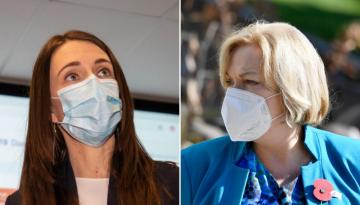The Director-General of Health is confident our COVID-19 cases are being appropriately managed but says modelling shows there is still a risk of a case outside of Auckland.
Prime Minister Jacinda Ardern announced on Monday that New Zealand's current alert level settings would be extended by a week. She said health advice suggested being cautious and spending more time tracking our current cases and sub-clusters. If nothing unusual pops up, the country can expect to see restrictions loosen next week.
Since Auckland moved to alert level 2.5 at the start of last week, 36 community cases have been recorded, all linked to the wider cluster and most of whom were contacts of already known cases. However, a sub-cluster has recently emerged around a series of bereavement events.
"This has led to 15 cases, and while there is no evidence of significant spread outside of the Auckland cluster, this event does raise the possibility that more people have been exposed within what is already our biggest cluster to date," Ardern said.
It was also revealed on Sunday that a healthcare worker at the Jet Park quarantine facility had contracted the virus and visited several North Shore sites, such as a gym and supermarket.
Asked on Tuesday if there was any possibility restrictions could be ramped up instead of relaxed, Dr Ashley Bloomfield said that was unlikely to be necessary.
"No, that's not really what the pattern of this outbreak has shown us. The number of cases has dropped quite a lot over the last week or so. We have a pretty good idea of the extent of the outbreak," the Director-General of Health told The AM Show.
"The infection of the health worker at the quarantine facility was a little bit of a curveball that came our way on Saturday. But again, we just applied the rapid isolation, contact tracing, testing that we have been doing through this outbreak which has served us really well."
Dr Bloomfield said he was confident cases are being adequately managed, but modelling shows there remains a chance a case could be outside of Auckland.
"We are confident that we have got the cases we know about appropriately managed. I guess the key issue we are looking at, both in Auckland and outside of Auckland - including in the South Island - is whether there are other cases that could have been seeded in the community over the last couple of weeks as the travel restrictions have lifted," he said.
"The modelling that was done at the end of last week by Professor Shaun Hendy and his team suggested there is still a risk that there could be a case elsewhere in the North Island of around 30 to 40 percent. Even in the South Island, it's lower, but it is still around 10 to 20 percent."
With each day, Dr Bloomfield said, that risk drops.
"By around next Monday, our feeling is, if there are no further surprises, particularly out of Auckland, then we have got a high level of confidence there would be any seeded events outside of Auckland."
The Director-General said people with symptoms are being tested in the South Island and all DHBs - particularly those with tourism centres - are doing asymptomatic testing on people who are likely to have come into contact with travellers, such as hotel workers and taxi drivers.
So far, since the most recent outbreak in mid-August, testing hasn't picked up any cases outside of Auckland except for several cases in Tokoroa last month linked to the Auckland cluster.
The Prime Minister said on Monday that she understood there would be questions as to why parts of the country outside of Auckland weren't moving down alert levels.
"Modelling done for the Ministry of Health continues to suggest around a 25 percent chance of cases moving outside of the Auckland region. So while the cases are currently in Auckland, with inter-regional travel open there remains a risk of spreading the virus to the rest of the country," Ardern said.
"We haven’t had many days without new cases appearing in Auckland and it only requires one person travelling and attending a super-spreader event somewhere else in the country and we could be looking at further restrictions everywhere. So the level 2 precautions we have in place continue to act as a safety barrier for flair-ups in the rest of New Zealand."



